Infortrend EonStor ESDS 3024RTEB review
A hybrid storage array combining high capacity, Fibre Channel and IP SANs at a sensible price
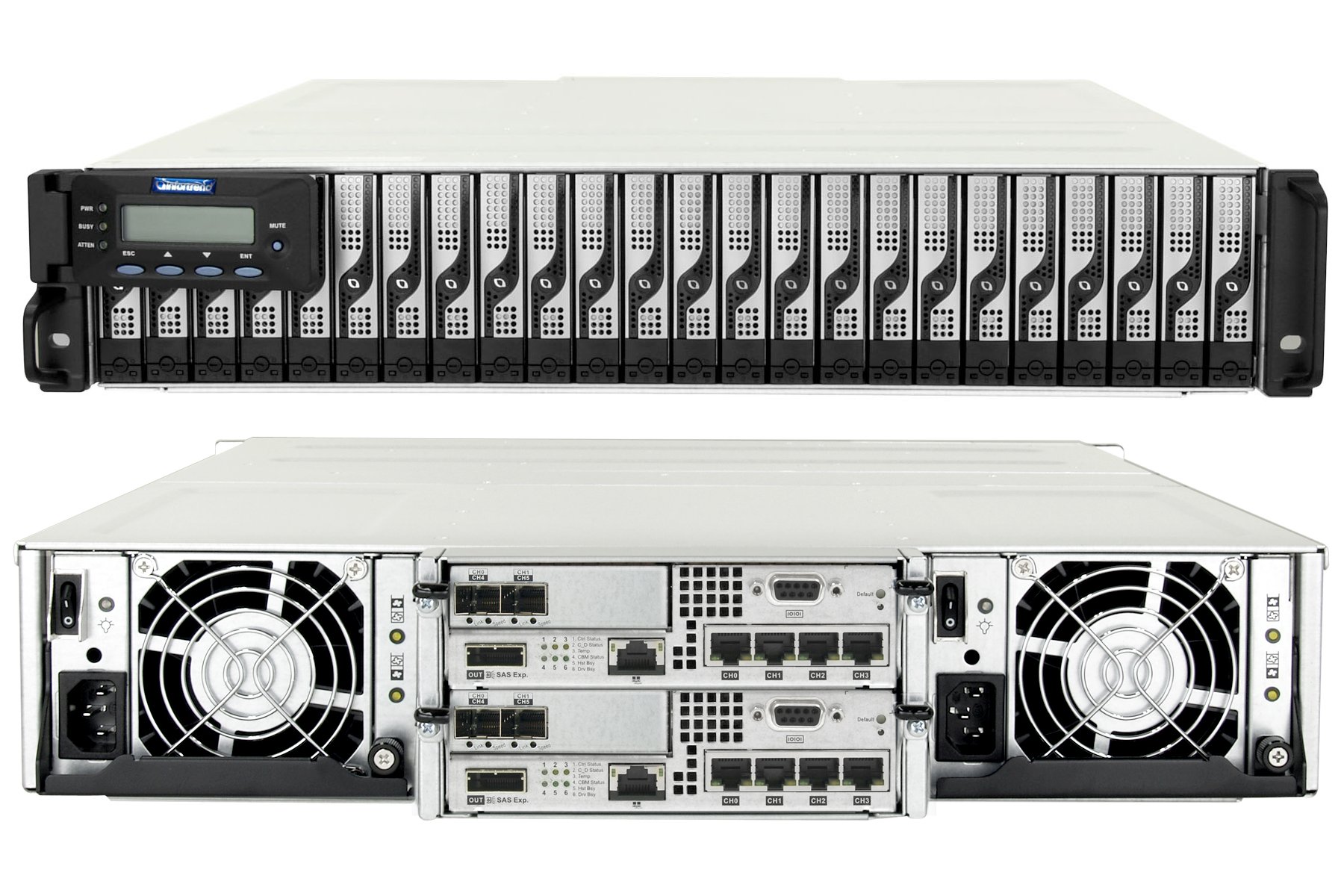

A versatile disk array with a tempting price tag. The ESDS provides top Fibre Channel performance, the compact form factor and affordable price and you have an ideal all-round storage appliance for SMBs.
-
+
Top performance; Affordable; Combined FC and IP SANs; All-round redundancy
-
-
Vague product manuals

The hybrid EonStor ESDS 3024RTEB offers a range of storage features including support for high-speed 16Gbps Fibre Channel SANs and IP SANs.
This 2U chassis has room for up to 24 SFF SAS or SATA hot-swap hard disks. Hardware redundancy is excellent as the device comes with a pair of hot-plug PSUs (combined with cooling fans) and dual controllers.
The controllers in the review system each have quad Gigabit iSCSI data ports plus the dual-port 16Gbps FC module. Other modules offered by Infortrend include quad 8Gbps FC or Gigabit iSCSI, dual 10GbE SFP+ or RJ-45 and dual 6Gbps SAS for direct attached storage.
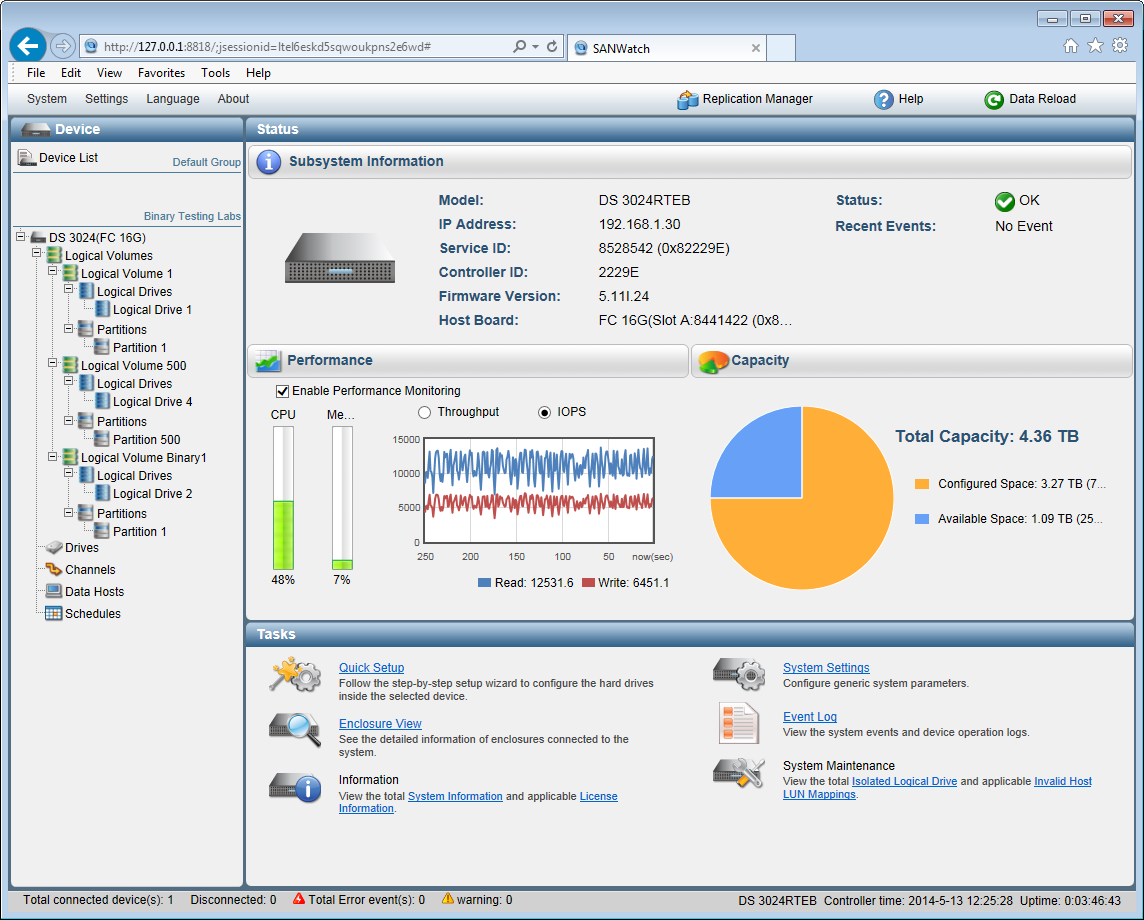
The SANWatch HTML interface allows you to manage multiple arrays and monitor performance
Controller conundrums
Each controller also has a 6Gbps SAS expansion port for daisy-chaining additional disk shelves via dual redundant links. You can mix and match Infortrend's JB 2024B, JB 2048 or JB 2060 disk shelves and the 3024RTEB supports a maximum of 360 drives.
Before you start dishing out storage it's worth getting to grips with how the new controllers function as this isn't obvious from the vague user manual. Controllers A and B function in active/active mode so all ports on both of them are available.
However, when you create a virtual volume you assign either A or B to it as the primary controller. This allows multiple ports on the primary controller to be used in MPIO links for increased bandwidth for the associated volume.
Host connections to the secondary controller are your redundant links. These are assigned to MPIO links but bandwidth is not aggregated with the primary link and are only used if the latter goes down.
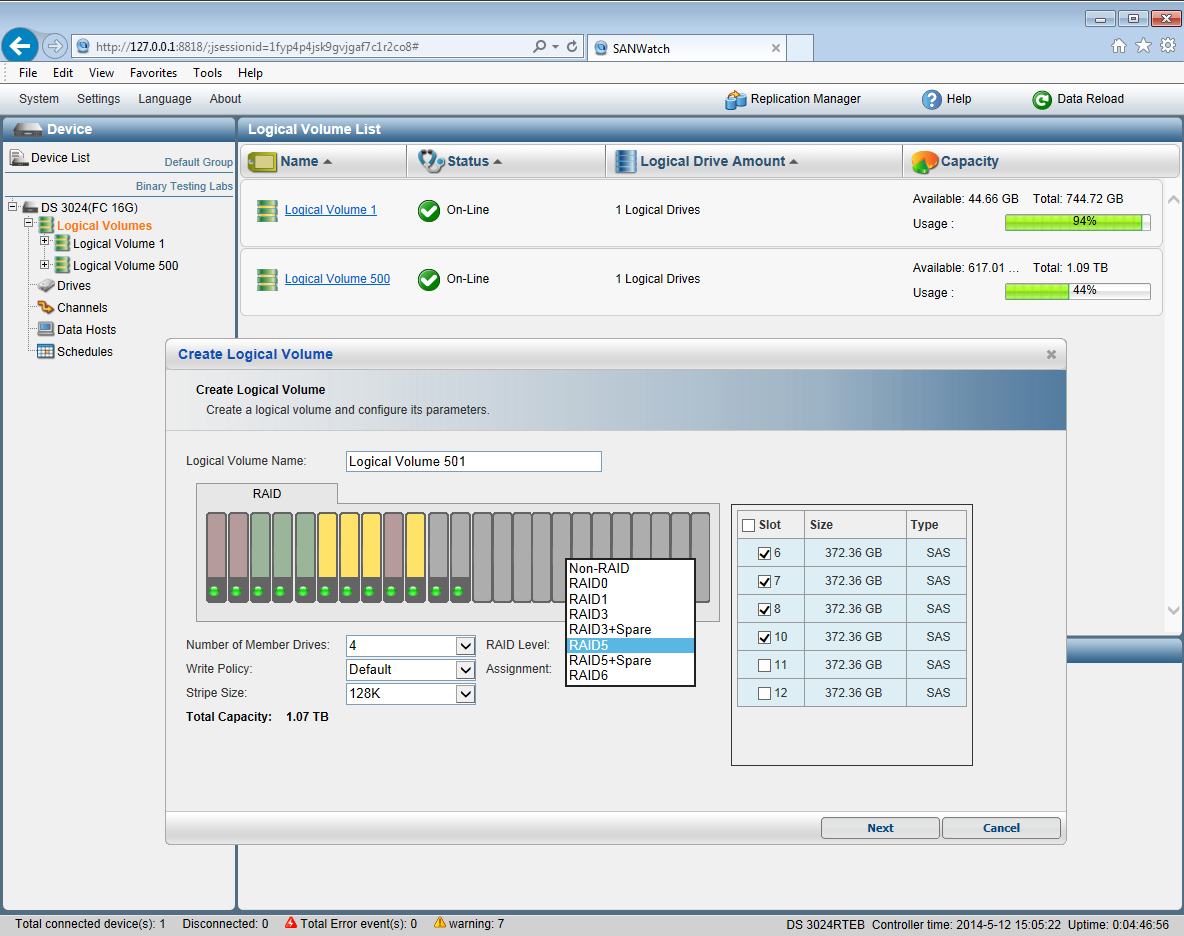
During logical volume creation you choose the member drives plus the RAID type
Installation and SANWatch
The controllers have dedicated network management ports but only the one on controller A is active. If it fails, its management IP address is shifted over to controller B for uninterrupted access.
For single array management you have the embedded RAIDWatch browser interface while the SANWatch utility remotely manages multiple devices. The interfaces are very similar but tasks such as snapshots, volume copies and replications can only be run from SANWatch.
When configuring storage, you create logical volumes with selected drives, choose a RAID array type and assign it a primary controller. This creates a logical drive in the volume and within this you create partitions which are the actual storage devices to be presented to servers
During partition creation you can enable thin provisioning and enter a percentage of the maximum size it should start at. Partitions are then mapped to the FC or iSCSI ports on either or both controllers.
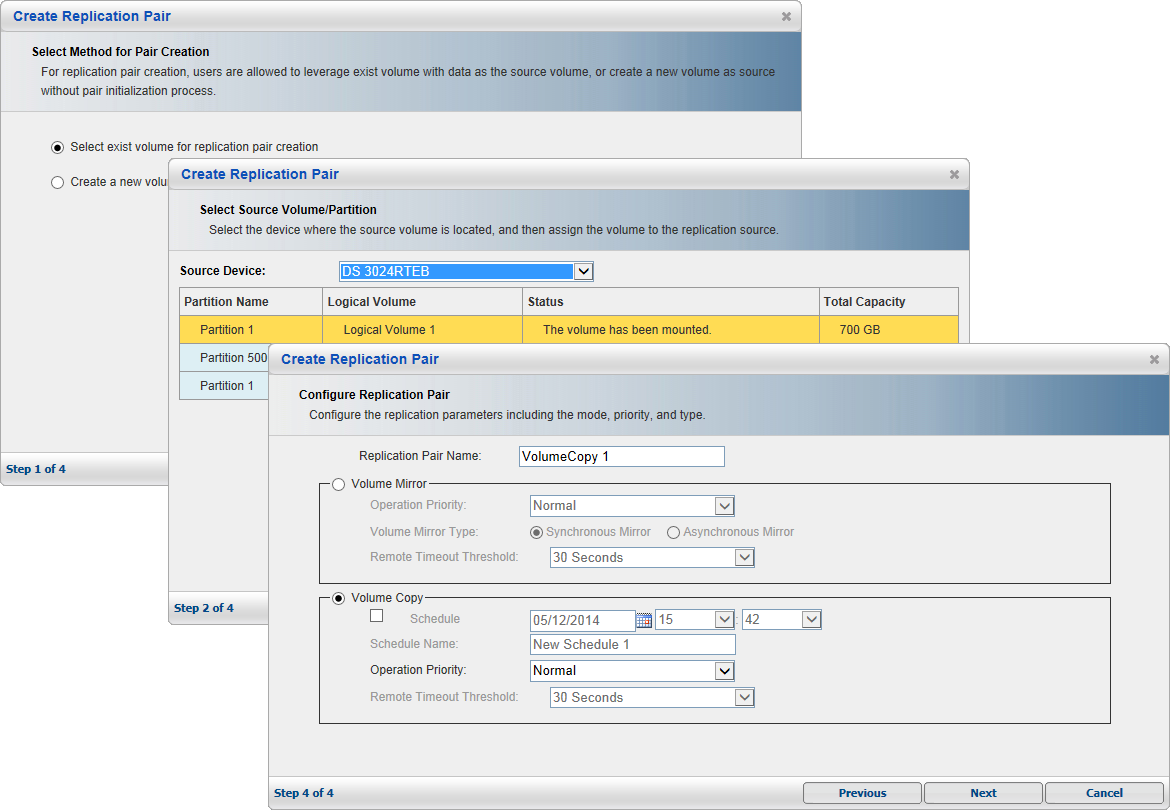
The SANWatch Replication Manager is used to create volume mirrors and copies
Snapshots and replication
Snapshots provide point in time copies of volumes with the standard license supporting 64 per volume and 128 per system. An advanced license upgrade increases the snapshot count to 256 and 4,096 respectively.
Snapshots can be run manually or to a schedule and for partition rollback you just select a snapshot from the list that you want to restore. Snapshots can be mapped to a host port and if the partition is being used by multiple hosts you'll need to install the SANWatch data agent on each one which flushes the cache prior to a snapshot being taken.
The optional replication feature adds volume mirroring and copying to the mix. Remote replication across two arrays is available and Infortrend has recently added a data tiering option where hot data is moved to SSDs.
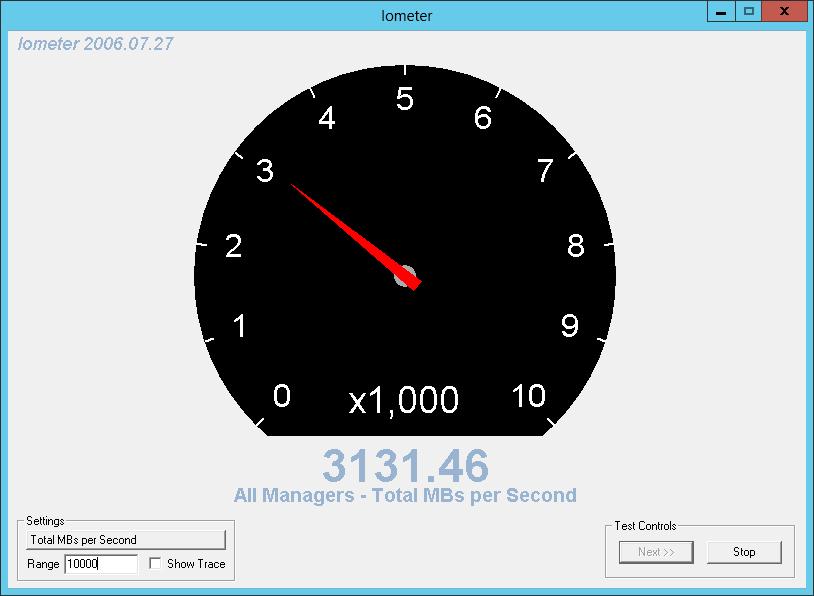
Iometer recorded an nippy 24.5Gbps over dual 16Gbps FC connections to our test server
A speedy performer
For FC performance testing we used a Broadberry Data Systems rack server with dual 2.6GHz E5-2670 Xeons, 48GB of DDR3, Windows Server 2012 R2 and a QLogic QLE2672 dual port 16Gbps FC adapter. Infortrend supplied the review system with a bunch of STEC SSDs which we used to create multiple triple disk RAID-5 partitions.
With a single direct attach FC connection, we saw Iometer return an impressive raw read speed of 1,560MB/sec. Looking back at our review of the 8Gbps FC equipped HP MSA 2040, we could see this was nearly twice as fast.
We then connected the server's second FC port to the partition's primary controller and saw raw read speed double to 3,132MB/sec nigh on 24.5Gbps. For database testing, we used 256 outstanding I/Os, a 16KB block size, 66 percent read, 34 percent write and a 100 percent random distribution. Over the dual-port FC connection Iometer returned an impressive 16,750 IOPS.
We also tested failover using the iSCSI ports where we created an MPIO connection using a link to each controller. As expected, Iometer returned an average raw read speed of 113MB/sec for the target which continued unabated when we pulled the network cable from the primary controller.
Conclusion
Infortrend's hybrid controllers make the EonStor ESDS 3024RTEB very versatile as their 16Gbps FC ports provide high-speed data access whilst the iSCSI ports can be used for low cost disaster recovery replication. Performance is impeccable and it crams in a lot of features and expandability for the price.
Verdict
A versatile disk array with a tempting price tag. The ESDS provides top Fibre Channel performance, the compact form factor and affordable price and you have an ideal all-round storage appliance for SMBs.
Chassis: 2U rack
Storage: 24 x SATA/SAS SFF hot-swap drive bays
Power: 2 x 530W hot-plug supplies with cooling fans
Two hot-swap RAID controllers each with the following:
Memory: 2GB cache (expandable to 16GB) with battery backup and CacheSafe
Array support: RAID0, 1, 3, 5, 6, 10, 30, 50, 60, JBOD, global hot-spare
Host interfaces: 4 x Gigabit iSCSI, 2 x 16Gbps FC
Network: Gigabit management port
Expansion: 6Gbps SAS port
Management: RAIDWatch web browser, SANWatch Suite
Get the ITPro daily newsletter
Sign up today and you will receive a free copy of our Future Focus 2025 report - the leading guidance on AI, cybersecurity and other IT challenges as per 700+ senior executives
Dave is an IT consultant and freelance journalist specialising in hands-on reviews of computer networking products covering all market sectors from small businesses to enterprises. Founder of Binary Testing Ltd – the UK’s premier independent network testing laboratory - Dave has over 45 years of experience in the IT industry.
Dave has produced many thousands of in-depth business networking product reviews from his lab which have been reproduced globally. Writing for ITPro and its sister title, PC Pro, he covers all areas of business IT infrastructure, including servers, storage, network security, data protection, cloud, infrastructure and services.
-
 ‘Phishing kits are a force multiplier': Cheap cyber crime kits can be bought on the dark web for less than $25 – and experts warn it’s lowering the barrier of entry for amateur hackers
‘Phishing kits are a force multiplier': Cheap cyber crime kits can be bought on the dark web for less than $25 – and experts warn it’s lowering the barrier of entry for amateur hackersNews Research from NordVPN shows phishing kits are now widely available on the dark web and via messaging apps like Telegram, and are often selling for less than $25.
By Emma Woollacott Published
-
 Redis unveils new tools for developers working on AI applications
Redis unveils new tools for developers working on AI applicationsNews Redis has announced new tools aimed at making it easier for AI developers to build applications and optimize large language model (LLM) outputs.
By Ross Kelly Published
-
 Google layoffs continue with "hundreds" cut from Chrome, Android, and Pixel teams
Google layoffs continue with "hundreds" cut from Chrome, Android, and Pixel teamsNews The tech giant's efficiency drive enters a third year with devices teams the latest target
By Bobby Hellard Published